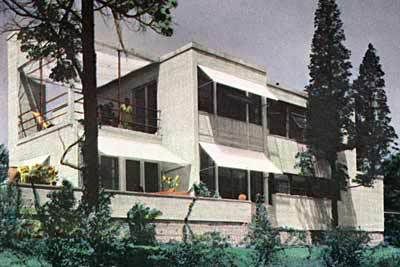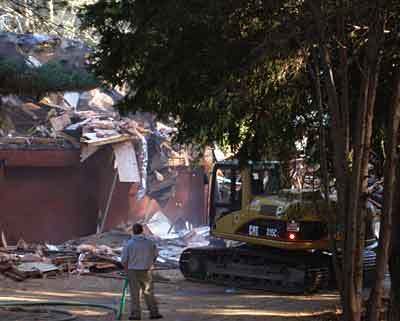briv
Senior Member
- Joined
- May 25, 2006
- Messages
- 2,083
- Reaction score
- 3
From the Arcitectural Record:
New England?s First Modernist House Destroyed
By Ted Smalley Bowen
January 9, 2007


Image from Eleanor Raymond, Architect, by Doris Cole, Art Alliance Press, 1981 (top); Photo: Marilyn Fenollosa (above).
The Rachel Raymond house in Belmont, Massachusetts, widely considered to be New England?s first Modernist dwelling, was demolished in October over the objections of local and national preservation groups.
According to advocates, the loss underscores the threat to Modernist architecture as development pressures, a sometimes-ambivalent preservation movement, and an uninformed public leave an increasing number of buildings at risk. Locally, the teardown has bolstered support for a Belmont-wide demolition delay ordinance.
The 1931 Raymond house was designed by pioneering architect Eleanor Raymond for her sister Rachel. The house, the first Modernist design by a woman in the U.S., predated by seven years the Gropius house in nearby Lincoln. Raymond designed her sister?s house after a 1930 visit to the Bauhaus school in Weimar, Germany, making her one of the first Americans whose work benefited from direct exposure International Style buildings, according to Helene Lipstadt, an architectural historian and Belmont resident.
In her half-century career, Raymond was also among the earliest to design houses using solar technology, plywood, and Masonite.
Lipstadt and fellow members of the New England chapter of DOCOMOMO, an international preservation group devoted to modern architecture, publicized the threat to the Raymond house after the Belmont Hill School purchased the property in October.
The private boys? school commissioned a study of the house prior to buying it for $1.85 million. The house had been considerably altered over the decades and its original character lost, headmaster Richard Melvoin argues: ?The report did indicate that one could try to get it back to the original design, but the cost would be huge.? The report, by local architect and architectural history professor John McConnell, is confidential, according to Melvoin.
Richard Cheek, an architectural photographer and chair of the Belmont Historic District Commission, met with school officials and was given a brief look at the report. ?It had flaws that the town and interested parties should have been allowed to address,? he says. And when DOCOMOMO/New England president David Fixler toured the house several years ago, he found the exterior significantly changed, ?but the general ambiance inside and how it related to the garden retained the original flavor,? he says. ?It would?ve been expensive to restore, but it was possible.? Belmont Hill School proceeded with demolition within a month of closing its purchase.
Cheek says the teardown should boost the chances of a proposed demolition delay bylaw that would apply town-wide; the current ordinance covers only Belmont?s historic district. Such laws provide time for discussion and ?preservation by shame,? Lipstadt adds. ?[But] there was no chance in this case.?
Link to article
New England?s First Modernist House Destroyed
By Ted Smalley Bowen
January 9, 2007


Image from Eleanor Raymond, Architect, by Doris Cole, Art Alliance Press, 1981 (top); Photo: Marilyn Fenollosa (above).
The Rachel Raymond house in Belmont, Massachusetts, widely considered to be New England?s first Modernist dwelling, was demolished in October over the objections of local and national preservation groups.
According to advocates, the loss underscores the threat to Modernist architecture as development pressures, a sometimes-ambivalent preservation movement, and an uninformed public leave an increasing number of buildings at risk. Locally, the teardown has bolstered support for a Belmont-wide demolition delay ordinance.
The 1931 Raymond house was designed by pioneering architect Eleanor Raymond for her sister Rachel. The house, the first Modernist design by a woman in the U.S., predated by seven years the Gropius house in nearby Lincoln. Raymond designed her sister?s house after a 1930 visit to the Bauhaus school in Weimar, Germany, making her one of the first Americans whose work benefited from direct exposure International Style buildings, according to Helene Lipstadt, an architectural historian and Belmont resident.
In her half-century career, Raymond was also among the earliest to design houses using solar technology, plywood, and Masonite.
Lipstadt and fellow members of the New England chapter of DOCOMOMO, an international preservation group devoted to modern architecture, publicized the threat to the Raymond house after the Belmont Hill School purchased the property in October.
The private boys? school commissioned a study of the house prior to buying it for $1.85 million. The house had been considerably altered over the decades and its original character lost, headmaster Richard Melvoin argues: ?The report did indicate that one could try to get it back to the original design, but the cost would be huge.? The report, by local architect and architectural history professor John McConnell, is confidential, according to Melvoin.
Richard Cheek, an architectural photographer and chair of the Belmont Historic District Commission, met with school officials and was given a brief look at the report. ?It had flaws that the town and interested parties should have been allowed to address,? he says. And when DOCOMOMO/New England president David Fixler toured the house several years ago, he found the exterior significantly changed, ?but the general ambiance inside and how it related to the garden retained the original flavor,? he says. ?It would?ve been expensive to restore, but it was possible.? Belmont Hill School proceeded with demolition within a month of closing its purchase.
Cheek says the teardown should boost the chances of a proposed demolition delay bylaw that would apply town-wide; the current ordinance covers only Belmont?s historic district. Such laws provide time for discussion and ?preservation by shame,? Lipstadt adds. ?[But] there was no chance in this case.?
Link to article
